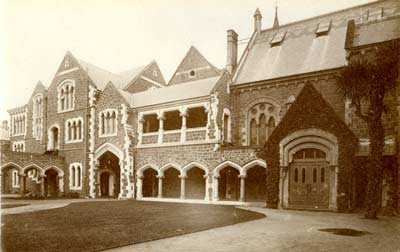The need for scientific and technical skills in a new colony was recognized early on in the development of Canterbury College. A School of Technical Science had been proposed for the Museum as early as 1870, and a Department was formally established in 1882, which was filled mainly with mining and mechanical models paid for by the Board of Governors. The School of Engineering was finally established at the College in 1887, and Robert Julian Scott was appointed to teach mechanical engineering. ‘Loppy’ Scott, as he was known by students, was a force to be reckoned with, and set about building an impressive empire.In 1887, the College estimated that Engineering would require only two lecture rooms, a room to house models, and a workshop under the superintendence of one or more skilled mechanics.

Mechanical Engineering Laboratory

From left to right: the Great Hall, Clock Tower, East Wing and finally the Mechnical Engineering Laboratory, all seen from inside the north quadrangle.
Funds were eventually secured and a Mechanical Engineering Laboratory was constructed between 1890 and 1891. It seems appropriate that in the same year the College began building the Engineering School, Christchurch hosted the first public display of Edison’s phonograph in New Zealand and the city’s first electric lights were turned on in Ballantynes.
Designed by Benjamin Mountfort at a cost of £2740, the Mechanical Laboratory fronted onto Worcester Street and adjoined the already completed East Wing extension to the Clock Tower. Scott tried to get the Board of Governors to buy apparatus for the building, including a testing machine, lathe, 8hp experimental engine, and a boiler. However the Board balked at the cost and consequently the equipment didn’t arrive until 3 years later in 1894. Ever the canny one, Scott promptly charged fees for using the testing equipment and asked for 50% of the fees for his supervision time. Occupied by Engineering up until the 1960s, the Lab later became a library annexe, and after transfer to the Arts Centre was well known as the home of the Southern Ballet.